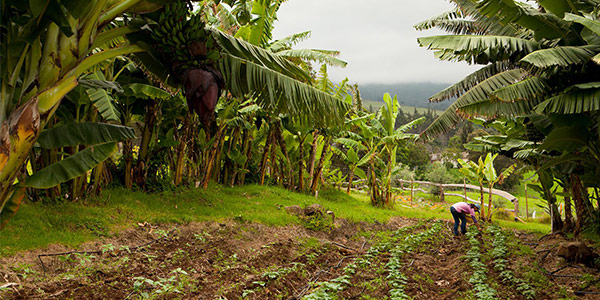A bill to make carbon offset projects affordable for small landowners is making its way through the Hawaii legislature.
Senate Bill 493 would establish an “agriculture and forest carbon-positive incentive program” to encourage small agricultural producers to reduce emissions by helping them pay for carbon sequestration efforts and clean energy use. Part of the state’s effort to reach carbon neutrality by 2045, the program is intended to create jobs and stabilize the food and water supply for a state almost entirely dependent on shipped goods.
The text of SB493 notes that “while carbon offset credits pay for carbon-positive actions, certification is cost prohibitive to small landowners. Incentivizing carbon-positive actions through a payment of services program would allow small farmers, ranchers and landowners to be compensated for taking actions to help Hawaii reach its climate-positive goal.”
The incentive program would be broken into two phases. Phase I activities would help farmers, ranchers and landowners implement a regenerative annual cropping system; improve pastureland, including growing trees and shrubs around pastures (agroforestry); engage in reforestation; protect land from disturbance; institute rotational grazing; and improve foraging.
Phase II activities would focus on energy creation and consumption. The program would cover, “but is not limited to,” biofuel production, methane capture, improved forest management, grazing intensity, mixed production systems, and efficient nutrient and waste management.
Details of SB493 are being debated, including how the incentives would be funded. The current bill proposes to create a special fund to be financed, in part, by revenue from the state’s Environmental Response, Energy and Food Security Tax. That tax was established in 2010 to discourage fossil fuel use and fund energy and food-security initiatives by adding $1.05/barrel tax to all petroleum products except aviation fuel. The bill also calls for unspecified funding from the state’s general revenue.
Various state agencies would have a hand in the program. Hawaii’s Department of Agriculture and Department of Land and Natural Resources (LNR) would establish compensation rates and contract terms for the program, with terms ranging from one to 30 years. The Hawaii Green Infrastructure Authority (HGIA) would establish and chair a committee to review applications, with participation from Agriculture and LNR. Eligibility would be determined at the point of application.
General administration of the program would fall to the HGIA and the state’s Greenhouse Gas Sequestration Task Force (GHGSTF), which was established in 2018 under the auspices of the Office of Planning (OP) to harmonize the state’s climate initiative goals with its clean energy and carbon sequestration efforts. The GHGSTF would be required to identify a number of program co-benefits, such as job creation; food security and agriculture for local consumption; water security; increased biodiversity; soil health; and invasive species reduction and removal.
Who’s in Charge?
The GHGSTF addressed SB493 during a Feb. 16 meeting, in which members also discussed various reports and plans pertaining to Hawaii’s broader 2045 carbon-neutral goal. During the meeting, OP Director and GHGSTF Chair Mary Alice Evans expressed concern that the task force does not have enough funding to meet its goal of providing state lawmakers with key reports.
“We weren’t able to get additional funding due to the pandemic, so we will have to make do with the vast expertise of our members to be able to meet at least the interim report and hope that by the time we get to the interim report that there are funds available to finish up the final report to the legislature,” Evans said.
In its Feb. 5 testimony on the bill, the GHGSTF explained that its role of identifying and prioritizing carbon-positive activities is jeopardized by a chronic lack of funding. Evans said, “The OP has struggled providing administrative support to the Greenhouse Gas Sequestration Task Force. Since 2018, the OP has noted this need for additional staffing and funding to support the task force’s work.” The GHGSTF’s Feb. 16 meeting was being held after “a yearlong hiatus because of these significant funding and staffing challenges,” Evans said.
Other testimony submitted Feb. 5 showed strong support for the bill, including from the LNR Department, the HGIA, the Sierra Club and the Environmental Caucus of the Democratic Party of Hawaii, along with smaller groups and individuals.
The Tax Foundation of Hawaii acknowledged the potential benefits of carbon sequestration but questioned whether they “justify grabbing a pot of barrel tax money without going through the normal budgeting process that also considers sweltering primary schools, underfunded state pensions, or disaster relief for rain-flooded or lava-burnt counties, as well as the economic decimation wrought by COVID-19.”
The group suggested that “a direct appropriation of general funds would be preferable” and that “earmarking revenues from any tax type for a particular purpose decreases transparency and accountability.” It also contended that Hawaii State Energy Office or Department of Agriculture would be better suited to administer the program than the HGIA.
The Agriculture Department testified that “the measure assigns extensive and unfamiliar responsibilities to the Department of Agriculture and the Department of Land and Natural Resources. … The department will need substantial assistance to acquire the appropriate expertise to develop compensation rates and carbon incentives contract terms, estimate sequestration rates for priority sequestration activities, develop the technical underpinning of compensation rates for sequestration activities, and conduct landowner outreach.” The agency also wondered what program beneficiaries would consider to be “fair compensation.”
Questioned about the probability of the bill passing, Evans told NetZero Insider that “the 2021 legislative session ends on April 29, and we often don’t know the fate of specific bills until the session adjourns.”


